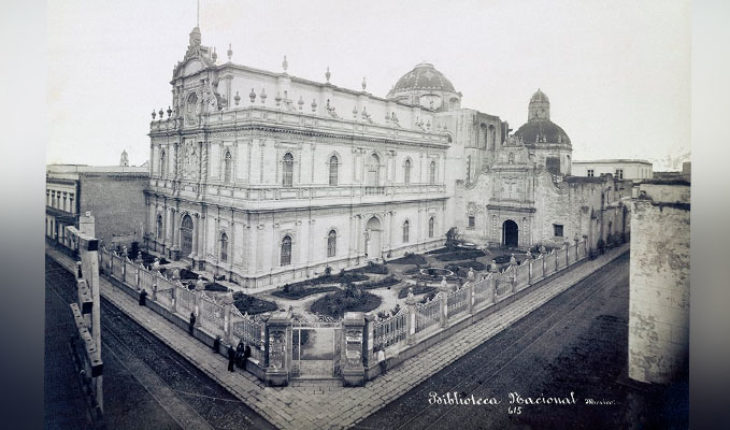Photos/Internet
Mexico.-a Mexican 19th century who loved books was the Jalisco José María Vigil (1829-1909). This thinker and journalist who is considered to be the promoter of the Librarianship in the country made possible one of the biggest dreams of former President Benito Juárez: convert a temple into a place of science, that is, the Republican transformation of the convent and Temple of San Agustín national library.
On the occasion of the international day of the book Chronicle reminiscent José María Vigil, who organized the books from the National Library of Mexico when it was located in the Center historic of the city of Mexico – today in University City-, and who recovered the manuscript of Mexican songs that years later would study the nahuatlato Miguel León-Portilla.
“José María Vigil is a figure of the 19th century from several points of view. As liberal has always had a Republican position, supported all Republican projects and one of them was the National Library of Mexico that was founded in 1867 by President Benito Juárez Decree”, said in an interview Miguel Angel Castro, researcher of the Institute for bibliographical research (IIB) of UNAM.
Also Coordinator of the recent book José María Vigil. One hundred years after his death edited by the IIB, indicates that Vigil arrived at the direction of the library which was then located in the convent and Temple of San Agustin (Republic of El Salvador 76, historic centre of the CDMX) in January 1881 and began the work of cataloguing of li Bros.
Although former President Benito Juárez did not see the total Republican transformation of the enclosure, José María Vigil transformed that Catholic property into the repository of all the publications of the country during the Government of Manuel González (1880-1884).
“The first stage of the work of Vigil was very important because it was the adaptation of the extemplo library. Many things were done because the mission was to transform what had been a religious space in a secular space. It went from Headquarters of the Catholic Church to Temple of wisdom and education, which was not easy”, talk to Castro.
The controversy of this transformation, accurate, was the loss of works of art novohispanic and although most are rescued for safekeeping in other spaces, Vigil remodeled the venue with outstanding architects of the time: Vicente Heredia and Eleuterio Méndez.
In the book, the researcher of the UNAM revisits the testimonies of the time where details that these architects built new facades on the North and West, became a door a niche for sheltering a statue of Minerva and retained the main cover, as well as the octagonal window of the choir, to mention some changes.
In this way, the national library was opened on April 2, 1884 and it took 45 years for this repository of books was administered by the National Autonomous University of Mexico (UNAM).” Collaborated on the book with the text Vigil and spirits, trustee of the National Library and when reopen this building of St. Augustine will return to consider many of the sculptures that I mention. For example, after criticism it was decided to keep the relief of St. Augustine attributed with reservations Claudio de Arciniega, and the chapel of the third order. In addition, at the gate were busts of important Mexican writers”, details the researcher.
Miguel Angel Castro added that once Vigil get underway the national library, the thinker of the 19th century began to make catalogs.
“Then there a discipline as it is now was that of librarianship, Vigil was a great librarian because undertook, by hand, the catalogs to organize books, which were acquired by legal deposit,” he says.
Years later, she adds, José María Vigil created Instituto Bibliográfico Mexicano (in 1889).
“It was by an invitation from the British who were beginning to identify national bibliographies, then was invited to Mexico to create his Commission to continue this work. Instituto Bibliográfico Mexicano thus was born inside the National Library”, details.
When arrived at the library national Vigil narrates that found half abandoned manuscript that caught her attention, so it began to study and years later, would be the doctor Miguel León-Portilla who will continue that work. It is of Mexican songs.
“This collection of poems and Nahua texts is one of the most valuable manuscript of the national library. Vigil rescued the document, studied it and even wrote the text Mexican songs. But yes, always interested to study nahuatl poetry,”responds.
The researcher of the UNAM stands Vigil worked with Irineo Paz, father of writer Octavio Paz. In the precise book that on January 1, 1833 he worked as editor of La Patria, whose address was in charge of Irineo Paz.
Jose Maria Vigil. One hundred years after his death, it brings together the work of 20 researchers from UNAM, including Pablo Mora, Lilia Vieyra Sánchez, Laurette Godinas, Evelia Trejo, Aurora Cano Andaluz and Edwin Alcantara Machuca.
Data on José María Vigil
He was director of the National Library of Mexico for 29 years.
He founded the first Association of journalists of Mexico.
In 1874, he founded the newspaper El Porvenir.
He was director of the Archivo General de la Nación from 1873 to 1875.
He began the publication of history of the Indies, Fray Bartolomé de las Casas and Mexican Chronicle by Fernando de Alvarado Tezozómoc.
Lived at number 18 from Arc de San Agustín, today Republic of El Salvador, in the historic center of Mexico City.
Source: Chronicle
translated from Spanish: The transformation of the Temple of San Agustín in the National Library of Mexico
April 23, 2019 |





